The Skoda Karoq and the VW T-Roc are two compelling offerings in the compact SUV segment, blending practicality with impressive performance. Both vehicles are designed to meet the diverse needs of modern drivers, but they have distinct characteristics that set them apart. This comparison will delve into their technical aspects, innovations, and overall performance.
Skoda Karoq vs VW T-Roc – Which one offers the better deal?
Both models have their strengths – but which one suits you more?
Compare performance, efficiency, price and space directly: Skoda Karoq or VW T-Roc?
Design and Dimensions
When it comes to dimensions, the Skoda Karoq measures 4,390 mm in length, while the VW T-Roc comes in at 4,236 mm to 4,271 mm, depending on the configuration. The Karoq's wider stance at 1,841 mm gives it a more robust appearance compared to the T-Roc, which ranges from 1,811 mm to 1,819 mm in width. Both models offer ample interior space, but the Karoq excels with a trunk capacity of 521 liters, significantly outpacing the T-Roc's maximum of 445 liters.
Powertrain Options
Under the hood, both SUVs provide a solid selection of engine options. The Skoda Karoq is available with petrol and diesel engines ranging from 115 HP to 190 HP, while the T-Roc offers a broader range, including a powerful 300 HP variant. The Karoq’s engines provide a balanced mix of performance and efficiency, achieving a fuel consumption as low as 4.9 L/100 km, whereas the T-Roc can reach as low as 4.7 L/100 km, depending on the engine configuration.
Transmission and Drivetrain
Both models come equipped with manual and automatic transmission options, including dual-clutch systems. The Karoq offers front-wheel and all-wheel drive variants, similar to the T-Roc, providing versatility for varied driving conditions. The T-Roc impressively features an optional 4Motion all-wheel-drive system, elevating its performance on challenging terrains.
Performance and Handling
Acceleration figures highlight the competitive nature of these SUVs. The Skoda Karoq achieves 0-100 km/h times between 7 to 10.6 seconds, while the VW T-Roc boasts quicker times, with some configurations as low as 4.9 seconds. However, the Karoq’s top speeds can reach up to 221 km/h, richer than some T-Roc models which max out at 218 km/h.
Innovation and Technology
In terms of technology, both vehicles are equipped with features aimed at enhancing comfort and safety. The Karoq boasts a spacious cabin with advanced infotainment systems, touch-sensitive controls, and a plethora of driver-assistance features such as adaptive cruise control and lane-keeping assist. The T-Roc, on the other hand, offers a more modern design aesthetic with customizable ambient lighting and an innovative digital cockpit, giving it a technology edge in user interface personalization.
Environmental Considerations
Both models are engineered with efficiency in mind. The Karoq has CO2 emissions ranging from 129 to 174 g/km, while the T-Roc ranges from 125 to 250 g/km. The Karoq generally sits in the D to F efficiency classes, whereas the T-Roc falls within D to G, marking a slight edge for Skoda in environmental performance, particularly in the lower emissions range.
Final Verdict
Ultimately, the choice between the Skoda Karoq and the VW T-Roc depends largely on personal preference and specific needs. The Karoq shines in terms of practicality with its spacious trunk and robust engine options, while the T-Roc appeals with its impressive tech features and sporty performance. Whether you're looking for more space or a more dynamic driving experience, both SUVs have a lot to offer in the competitive compact SUV market.
Here’s where it gets real: The technical differences in detail
Costs and Efficiency:
Price and efficiency are key factors when choosing a car – and this is often where the real differences emerge.
VW T-Roc has a to a small extent advantage in terms of price – it starts at 26400 £, while the Skoda Karoq costs 29100 £. That’s a price difference of around 2644 £.
Fuel consumption also shows a difference: Skoda Karoq manages with 4.90 L and is therefore slightly more efficient than the VW T-Roc with 5.50 L. The difference is about 0.60 L per 100 km.
Engine and Performance:
Power, torque and acceleration say a lot about how a car feels on the road. This is where you see which model delivers more driving dynamics.
When it comes to engine power, the Skoda Karoq has a evident edge – offering 190 HP compared to 150 HP. That’s roughly 40 HP more horsepower.
In acceleration from 0 to 100 km/h, the Skoda Karoq is distinct quicker – completing the sprint in 7 s, while the VW T-Roc takes 8.90 s. That’s about 1.90 s faster.
In terms of top speed, the Skoda Karoq performs minimal better – reaching 221 km/h, while the VW T-Roc tops out at 212 km/h. The difference is around 9 km/h.
There’s also a difference in torque: Skoda Karoq pulls noticeable stronger with 360 Nm compared to 250 Nm. That’s about 110 Nm difference.
Space and Everyday Use:
Cabin size, boot volume and payload all play a role in everyday practicality. Here, comfort and flexibility make the difference.
Both vehicles offer seating for 5 people.
In curb weight, Skoda Karoq is slight lighter – 1380 kg compared to 1465 kg. The difference is around 85 kg.
In terms of boot space, the Skoda Karoq offers minimal more room – 521 L compared to 475 L. That’s a difference of about 46 L.
In maximum load capacity, the Skoda Karoq performs to a small extent better – up to 1630 L, which is about 280 L more than the VW T-Roc.
When it comes to payload, Skoda Karoq barely noticeable takes the win – 549 kg compared to 515 kg. That’s a difference of about 34 kg.
Who comes out on top?
Overall, the Skoda Karoq shows itself to be wins the duel decisively and secures the title of DriveDuel Champion.
It convinces with the more balanced overall package and proves to be the more versatile choice for everyday use.
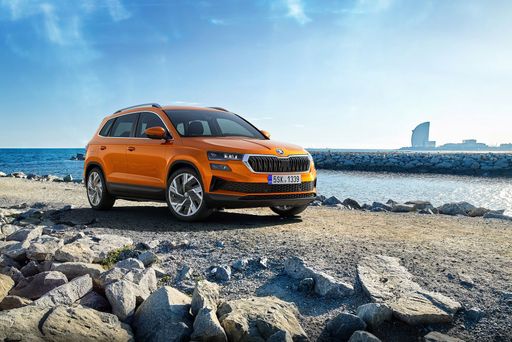 @ Škoda Auto a.s. / Škoda Storyboard
@ Škoda Auto a.s. / Škoda Storyboard
Skoda Karoq
Skoda Karoq
The Skoda Karoq is a smart, unfussy compact SUV that blends roomy practicality with a pleasantly composed driving character. It won’t turn heads at a car meet, but it will make daily life easier with clever storage, sensible ergonomics and a reassuringly grown-up ride.
details @ Škoda Auto a.s. / Škoda Storyboard
@ Škoda Auto a.s. / Škoda Storyboard
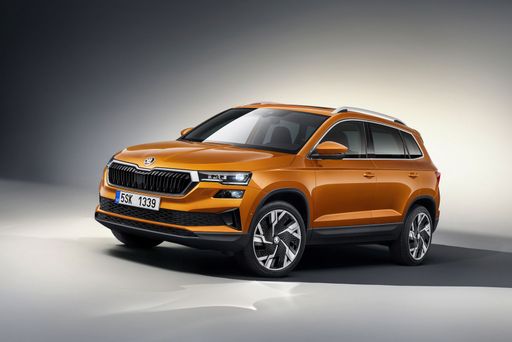 @ Škoda Auto a.s. / Škoda Storyboard
@ Škoda Auto a.s. / Škoda Storyboard
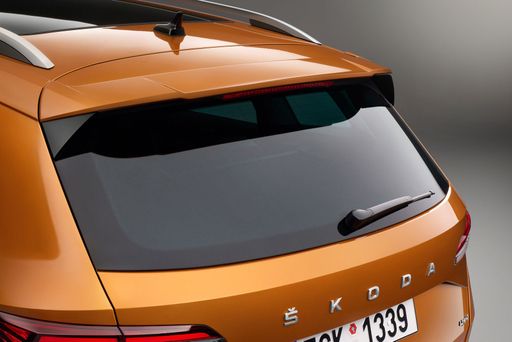 @ Škoda Auto a.s. / Škoda Storyboard
@ Škoda Auto a.s. / Škoda Storyboard
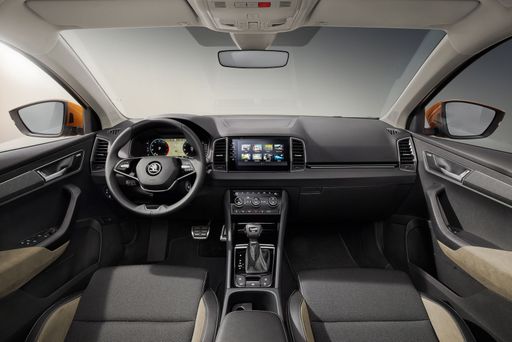 @ Škoda Auto a.s. / Škoda Storyboard
@ Škoda Auto a.s. / Škoda Storyboard
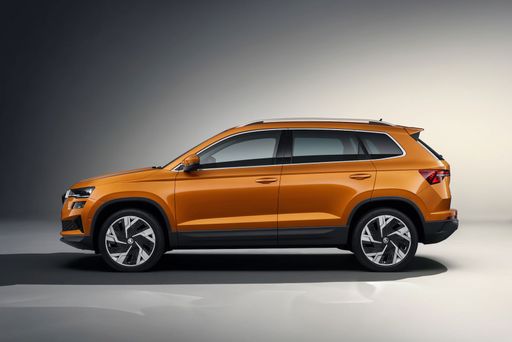 @ Škoda Auto a.s. / Škoda Storyboard
@ Škoda Auto a.s. / Škoda Storyboard
VW T-Roc
The VW T-Roc mixes cheeky, coupe-like styling with the everyday sense and space of an SUV, so it looks fun without sacrificing family sense. It’s a likeable all-rounder with tidy road manners and plenty of personality, ideal if you want a car that’s practical enough for chores but entertaining enough to enjoy.
details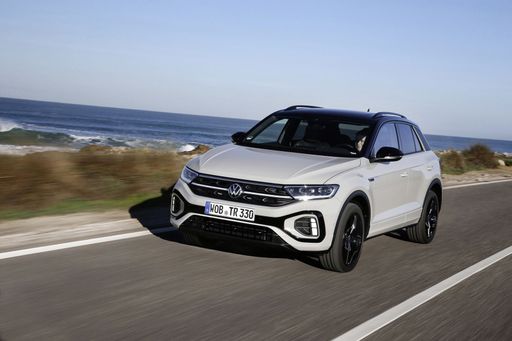 @ Volkswagen AG / VW Media
@ Volkswagen AG / VW Media
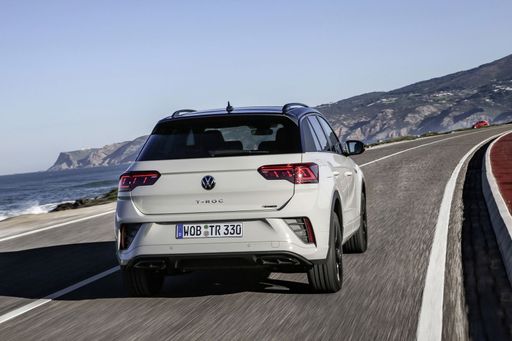 @ Volkswagen AG / VW Media
@ Volkswagen AG / VW Media
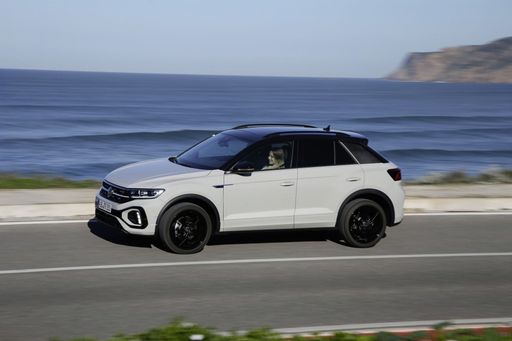 @ Volkswagen AG / VW Media
@ Volkswagen AG / VW Media
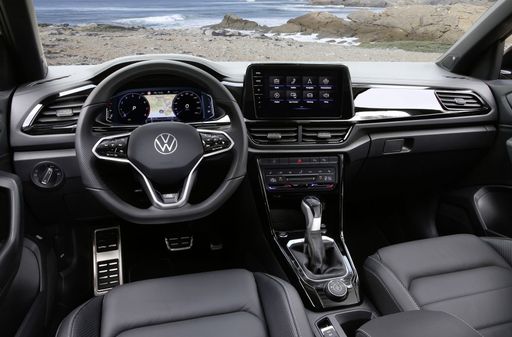 @ Volkswagen AG / VW Media
@ Volkswagen AG / VW Media
 @ Škoda Auto a.s. / Škoda Storyboard
@ Škoda Auto a.s. / Škoda Storyboard
|
 @ Volkswagen AG / VW Media
@ Volkswagen AG / VW Media
|
|
|
|
Costs and Consumption |
|
|---|---|
|
Price
29100 - 41700 £
|
Price
26400 - 38000 £
|
|
Consumption L/100km
4.9 - 7.6 L
|
Consumption L/100km
5.5 - 6.3 L
|
|
Consumption kWh/100km
-
|
Consumption kWh/100km
-
|
|
Electric Range
-
|
Electric Range
-
|
|
Battery Capacity
-
|
Battery Capacity
-
|
|
co2
128 - 173 g/km
|
co2
126 - 143 g/km
|
|
Fuel tank capacity
50 - 55 L
|
Fuel tank capacity
50 L
|
Dimensions and Body |
|
|---|---|
|
Body Type
SUV
|
Body Type
SUV
|
|
Seats
5
|
Seats
4 - 5
|
|
Doors
5
|
Doors
2 - 5
|
|
Curb weight
1380 - 1655 kg
|
Curb weight
1465 - 1539 kg
|
|
Trunk capacity
521 L
|
Trunk capacity
284 - 475 L
|
|
Length
4384 - 4390 mm
|
Length
4271 - 4373 mm
|
|
Width
1841 mm
|
Width
1811 - 1828 mm
|
|
Height
1624 - 1629 mm
|
Height
1527 - 1573 mm
|
|
Max trunk capacity
1630 L
|
Max trunk capacity
1350 L
|
|
Payload
456 - 549 kg
|
Payload
368 - 515 kg
|
Engine and Performance |
|
|---|---|
|
Engine Type
Petrol, Diesel
|
Engine Type
Petrol, Petrol MHEV
|
|
Transmission
Manuel, Automatic
|
Transmission
Manuel, Automatic
|
|
Transmission Detail
Manual Gearbox, Dual-Clutch Automatic
|
Transmission Detail
Manual Gearbox, Dual-Clutch Automatic
|
|
Drive Type
Front-Wheel Drive, All-Wheel Drive
|
Drive Type
Front-Wheel Drive
|
|
Power HP
115 - 190 HP
|
Power HP
115 - 150 HP
|
|
Acceleration 0-100km/h
7 - 11.2 s
|
Acceleration 0-100km/h
8.9 - 12.3 s
|
|
Max Speed
192 - 221 km/h
|
Max Speed
187 - 212 km/h
|
|
Torque
200 - 360 Nm
|
Torque
200 - 250 Nm
|
|
Number of Cylinders
3 - 4
|
Number of Cylinders
3 - 4
|
|
Power kW
85 - 140 kW
|
Power kW
85 - 110 kW
|
|
Engine capacity
999 - 1984 cm3
|
Engine capacity
999 - 1498 cm3
|
General |
|
|---|---|
|
Model Year
2025
|
Model Year
2024 - 2025
|
|
CO2 Efficiency Class
D, E, F
|
CO2 Efficiency Class
E, D
|
|
Brand
Skoda
|
Brand
VW
|
What drive types are available for the Skoda Karoq?
The Skoda Karoq is offered with Front-Wheel Drive or All-Wheel Drive.
The prices and data displayed are estimates based on German list prices and may vary by country. This information is not legally binding.
